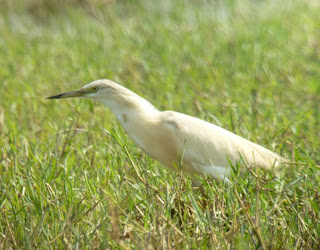Identification of teals from Spain
Anas crecca
cerceta común
– common teal – xarxet comú – zertzeta arrunt – cerceta común
Maybe the smallest of our ducks, with 34-38 cm and 53-59 cm of wingspan. Males
are grey, with reddish head, a green ocular band and a yellow triangle under
the tail. The males also have a withe band in the wing visible when the bird
isn’t flying (scapular list). Females
are brown and spotted, but the small size and green speculum in the wing
distingued it from other species. Juveniles
are so similar than females but with more orange in the lawer jaw.
Distribution
The common teal is a common duck in all the Iberian
Peninsule. We find it specially at winter, when
thousands of teals arrive to Spain from other places of Europe. In some
places we can also find some breeding pairs, but is rare to find breeding
populations.
Anas carolinensis
cerceta
aliverde o americana – green winged teal – xarxet americà
Similar size than common teal, 34-38 cm and 53-59 cm of
wingspan. Males are so easy to
identify, they have a withe band in the side (the common teal have got a scapular
list) and the breast is redder than the common one. Females are one of our ducks more difficult to identify, and if they
don’t go with a male we can’t be sure that the identification is good.
Green winged females almost always have the head marks more marked than common teals.
The other thing that can help us in the identification of females is the band
of the wing, usually reddish ore ligth orange in green winged teal and withe in
common teal. Juveniles are similar
than females.
Distribution
Excepcional vagrant, maybe there are some few birds
that remains all the year in Europe, but we can’t say it for sure.
Anas querquedula
cerceta
carretona – garganey – xarrasclet – uda-zertzeta – cerceta do estío
Small size, with 37-41
cm and 59-67 cm of wingspan. Males are unmistakable, with grey and
brownish body, brown breast and head and a withe “eyebrow”above the eyes. Females are a little bite more
difficult to identify. They have marked marks in the head and withish spots in
the “eyebrow”, the base of the bill and the throat. The bill is longer and
heavier than in other small ducks. They also have grey wings, without green or
blue in the speculum. Juveniles are similar
than females but with diffuse spots and marks on the head.
Distribution
In the migrations we find it in all the south of the
Iberian Peninsule, and we find breeding populations in Doñana (Huelva), with irregular
nidifications at Delta de l’Ebre (Tarragona) and Aiguamolls de l’Empordà (Girona).
Anas discors
cerceta
aliazul – blue winged teal – xarxet alablau – zertzeta hegalurdin –
cerceta aliazul
Small size, like other teals. 37-41 cm and 59-67 cm of
wingspan. Males are unmistakable,
with brown and spotted body, grey or blue head with a withe spot like a moon
between the eye and the bill and a withe spot on the side, near the tail. Females are similar than the garganey,
but without withish spots (except for one at the base of the bill) and with the upper
part of the wing in blue color and a green speculum. Juveniles
are similar than females.
Distribution
American species, vagrant in Spain. Some of them are
escaped birds.
Anas formosa
cerceta del Baikal – Baikal teal – xarxet
del Baikal
39-43 cm
and 60-65 cm of wingspan. Males are, like other teals,
unmistakable, with grey body, pink breast and strange marks on the face with
black, green and yellow. Females are
also diferent from other teals, with marked marks in the face. They have withe
throat, dark head, a dark spot in the cheek and a withe spot in the base of the
bill surrounded of dark. Juveniles have
also this spot, but they are lighter than females and they have a brown –
reddish breast.
Distribution
Rare in Spain, usually the observations of this bird
are fruit of escapaments.



Comentaris